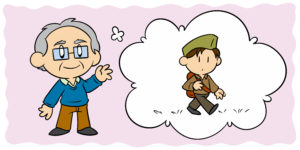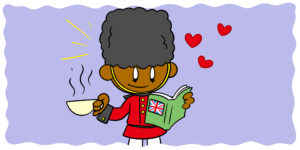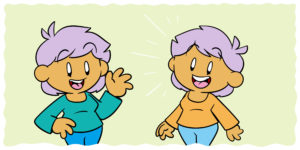Most authors who have tried to get published have heard of high-concept fiction, though the concept (pun totally intended) can be a little fuzzy. Let’s talk about what ‘high concept’ means and how you can make it part of your writing repertoire.
‘High concept’ defined
The idea is fairly simple: high-concept writing places high value on the story’s concept. I boil it down to these four qualities, with potential for expansion or crossover:
- Premise-driven
- Suited for a wide audience
- Unique
- Immediately intriguing
The pitch for a high-concept book most likely precedes the work itself, and the idea is so creative that people – lots of people – will want to read it based off an incredibly brief description. These are the book blurbs that make publishers and potential readers go, “Wow, I never thought of that before. I want to know where this is going.”
High-concept fiction builds out from a simple, irresistible idea.Click To TweetThough characters, dialogue, style – all the important story elements – are still necessary, the driving force behind the project is the premise. Take a look at a few examples and their premise-heavy pitches:
- Life of Pi: after a shipwreck, a young boy must share his lifeboat with a tiger.
- Misery: a famous author is imprisoned by a deranged fan who doesn’t approve of his latest work.
- The Da Vinci Code: Jesus had a wife and child, and the proof is hidden in works of art that you already recognize.
- Perelandra: ‘Genesis’ plays out on another planet, but someone from Earth is there to see it.
- The Thursday Next books: Book 1 – What if there was a parallel reality where all of fiction lived in harmony, knowing it was being read? Books 2–7 – What if the fiction thing, but in a world that also has vampires, time travel, and cloning?
- Pontypool Changes Everything: A zombie-esque virus is being spread through language, and it’s up to linguists to save us all.
- Firefly: what if colonized space became a new Wild West?
- Inception: what if being able to burgle dreams meant you were never sure you were awake?
- Groundhog Day: a dishonest man is forced to relive the same day over and over again, desperate to break the loop.
These are the types of story where the core idea is so good (and immediately understandable) that you immediately want to know the details. It’s the type of movie where, even though you immediately want to see it, you have to fight the urge to go on Wikipedia and look up everything that happens.
Okay, it’s pitchy. What’s the point?
Especially in the age of digital reading, selling a book is hard. Every book blurb is one of hundreds outlining similar themes, evoking similar emotions, and trying to nab potential readers’ attention before it flits off, victim to Instagram addiction and clickbait.
Actually, ‘clickbait’, apart from its negative connotations, isn’t a bad way to describe what we do when we write high-concept fiction. The premise, as encapsulated in a few carefully chosen words, is so compelling that people can’t resist reading more. A truly unique premise helps you get readers’ and publishers’ attention in a very crowded space. Why? Because truly unique is a rare thing, and people crave novelty.
In the age of clickbait, high-concept fiction is ideally placed to fight for readers.Click To TweetIs it necessary for a book to be high concept in order to succeed? Not at all. A Willa Cather novel won’t sell for its pitch. Imagine it: The Song of the Lark – a girl grows up to be a singer. Readers won’t exactly flock in droves. Rather, they come for Cather’s style and characters. They come for the perfect turn of phrase and the nostalgic setting. However, authors – especially those without preexisting reputations – might benefit from using high concepts as hooks.
High concept = high impact = high risk
For a book to be high concept, it isn’t enough to make a simple swap (what if Alice in Wonderland had been a boy?); the fallout from that swap should be significant. Take the Lord of the Flies. There’s a familiar premise: stranded on an island. And a twist: the only people on the island are kids. In the absence of adults, sociopolitical norms, and basic survival equipment, the potential impact is enormous and, it turns out, catastrophic. This could be called internal impact – the unique premise of a high-concept book must have significant implications for the plot and characters.
The value of a high-concept idea is how a simple premise ripples through the wider story.Click To TweetThe premise also needs to have what might be called external impact: readers have to care. In other words, a weird or random twist isn’t going to work. An ant aspiring to be a horse might work in a kids’ book (operative word ‘might’), but a person would have to be a helluva good writer to pass off a novel with this premise.
Lastly, high-concept writing is risky. A powerful premise that doesn’t deliver (a) is a huge letdown and (b) can ruin your reputation. If you promise big and deliver ‘meh’, the next big idea you have might as well be a paper boat in the Pacific: doomed.
There’s no how-to manual
So you’ve decided to give it a go, and you want to know how to get started. The tricky thing about high-concept fiction is that the premise has to be original. If there were a formula, or a pre-generated list of premises, that would defeat the purpose a bit. However, here are some ideas to get your thought wheels churning:
- Pick a famous quotation. Use it as a springboard either by (a) imagining someone else, someone radically different, said it or (b) constructing a world based on that quotation.
- Take two things that go well together. Change one of them. ‘Ice cream with a fly topping’? Sorry, Rick and Morty beat you to it.
- Think of a fairytale or ancient myth. Ask ‘what if’ questions about it. What if this took place two thousand years later? What if all the characters were _________? What if the villain was secretly ________? What if… what if… what if…?
- To think of something no one’s ever thought of, create a mind map of all the types of things somebody has already thought of. You can then use the visual to (a) look for gaps or (b) draw lines between unlikely things.
- Hang out with seven-year-olds. Listen to the questions they ask and imagine alternative answers. “Why is the sky blue?” Why might the sky be blue if we didn’t have a real answer for that question?
- Become a seven-year-old. Get curious. Ask questions about everything. Why do we have black holes? How would the world be different if people didn’t have reproductive parts? What if the cure for cancer actually exists, but [insert fallout here]? What outrageous, fascinating, absurd Q&As can you come up with? The beauty of a child’s imagination is that it isn’t fettered by a sense of embarrassment or an overuse of Google.
- Expose yourself to new ideas all the time. Read things you wouldn’t normally read. Go new places. Talk to people you don’t like. Open your eyes and mind and try to look for the unseen.
- Take a break from the internet. You know that feeling when you hear a riddle and then hear the answer? Immediate relief. But if you haven’t wrestled with it, your brain hasn’t gotten any exercise. Same thing when you try to find a unique idea by looking at everybody else’s ideas. When you’re on the internet, you get a satisfied sort of feeling: ‘Oh yeah! That’s a great idea for high-concept fiction, I totally see what they did there.’ But if you haven’t wrestled with your own fledgling ideas (and mind-wrestling hurts), you’ll be struggling to avoid copycatting.
Conclusion: where do I go from here?
The hardest part about writing high-concept fiction is coming up with a killer premise. The other hardest part about writing high-concept fiction is putting in the creative work that will bring that premise to life. A checklist for your high-concept project might go like this.
Step 1: Think of amazing concept.
Step 2: Imagine potential fallout based on this premise until a viable plot begins to formulate.
Step 3: Identify characters that could carry that plot.
Step 4: Check out some Standout Books articles that will support you through the writing process (Why More Authors Should Harness The Power Of Conceit and You’re Making A Mistake In Your World Building: Here’s How To Fix It are good places to start).
What high-concept ideas are rolling around in your head, and how do you approach them in your writing? Let me know in the comments.






10 thoughts on “What Is ‘High-Concept’ Fiction, And How Can I Write It?”
Great article Rebecca! I find the hardest part about writing high concept fiction is less about actually coming up with the idea, and more about executing it to it’s fullest. Just as you said, you can’t disappoint your readers after presenting them with such an exciting premise.
I like to write my premise out on an index card and keep it hanging in front of my work space. That way, I can always reference it and remind myself what I’m trying to live up to!
Hi, Lewis, thanks for your feedback!
I like your idea for index card inspiration. Good luck with your projects!
Best wishes,
Rebecca Langley
Rebecca,
Thank you for this article. I am in the process of writing my first book. After reading your article I am challenged to rethink my concept. You’ve made several very interesting suggestions and although i’m not sure yet where or how they will impact my work, but I’m definitely going to consider their incorporation into my project.
Thanks again,
Lou Aandreadis
Hi, Lou.
Thanks so much for your kind words. I’m glad you enjoyed the article. Congratulations, too, on writing your first book (in progress!). Best of luck, and feel free to let me know if you have questions along the way.
Best wishes,
Rebecca Langley
An amazing article! I have practiced a couple of those techniques (but to be honest i never knew it was a productive reason to do so). I always get such a feeling of new energy after reading them. Thank you and Happy New Year!
Greg
Thanks, Greg! Your words are so encouraging. Happy new year to you as well, and good luck in your writing endeavors.
Best wishes,
Rebecca Langley
Great article Rebecca! Everything else I have read about “high-concept” left me confused. I will certainly be using these ideas in planning my first fiction series. I like the idea of writing out your high-concept on an index card and putting it up prominently in your writing space – thanks to Lewis.
Hi, Bruce,
Thanks for your feedback. I’m so glad you found some clarification here. And yes, thanks again Lewis for the practical application.
Best wishes,
Rebecca
Hi Rebecca, if a novel can be summed up by its’ cover art and title and those things make people want to give it a try then is that high concept?
Hi, Paul, thanks for reading!
It sounds like what you’re describing could be considered high concept, but it’s hard for me to say without an example. What’s catchy about high concept is the premise, so if the title and cover somehow have enough detail to convey the premise of the book, that might work. I typically think of high concept in terms of the blurb about the book, though. Sorry for the vague answer, hopefully that answers your question.
Best wishes,
Rebecca